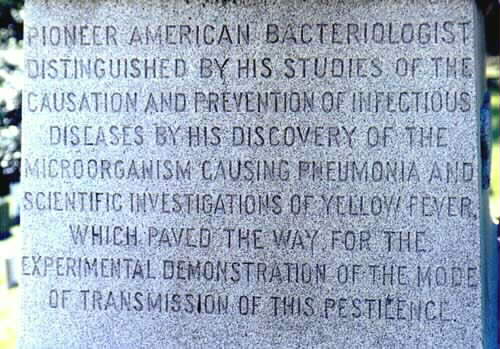Born at Hartwick Seminary, Otsego County, New York, on June 8, 1838, he received a medical degree from the Maryland College of Physicians in 1860.
He was appointed Assistant Surgeon, United States Army, on May 28, 1861; Captain, May 28, 1866; Major (Surgeon), December 1, 1873; Lieutenant Colonel (Surgeon), January 12, 1891, Brigadier General, Surgeon General, May 30, 1893; and retired from the Army on June 8, 1902.
During the Civil War, he began his service with the Army of the Potomac, later transferring to the Department of the Gulf. At the end of the war, he was in command of the US General Hospital, Cleveland, Ohio. He served throughout the Cholera and Yellow Fever epidemics in the United States and was a member of the Yellow Fever Commission, and the National Board of Health. He was widely credited with the development of ambulance services for wounded soldiers in the Civil War and many of his battlefield treatment methods remain in place today.
He died on November 3, 1915 and was buried in Section 2 of Arlington National Cemetery. His wife, Martha L. Pattison Sternberg, is buried with him.
Courtesy of the United States Army
GEORGE MILLER STERNBERG (June 8, 1838 – Nov. 3, 1915), Surgeon General, May 30, 1893 – June 8, 1902, was born at Hartwick Seminary, Otsego County, N. Y., where he spent most of his childhood. His father, Levi Sternberg, a Lutheran clergyman who later became principal of Hartwick Seminary, was descended from a German family from the Palatinate, which had settled in the Schoharie valley in the early years of the eighteenth century. His mother, Margaret Levering (Miller) Sternberg, was the daughter of George B. Miller, also a Lutheran clergyman and professor of theology at the seminary, a Lutheran school. George was the eldest of a large family and it was necessary for him to lift from his father’s shoulders as much as he could of the burden of its support. His studies at the seminary were interrupted by a year of employment in a bookstore in Cooperstown and by three years of teaching in neighboring rural schools. During his last year at Hartwick he was an instructor in mathematics, chemistry, and natural philosophy, and at the same time was pursuing the study of medicine with Dr. Horace Lathrop of Cooperstown. For his medical studies he went first to Buffalo, New York, and later to the College of Physicians and Surgeons of New York where he received the degree of M. D. in the spring of 1860. Following graduation he settled in Elizabeth, New Jersey, for practice and remained there until the outbreak of the Civil War.
He was appointed an assistant surgeon in the United States Army on May 28, 1861, and on July 21 of that year he was captured at the Battle of Bull Run, while serving with General George Sykes’ division. He was able to escape and soon joined his command in the defense of Washington. Later he participated in the Peninsular campaign and saw service in the battles of Gaines’ Mill and Malvern Hill. During this campaign he contracted typhoid fever while at Harrison’s Landing and was sent north on a transport.
During the remainder of the war he performed hospital duty, mainly at Portsmouth Grove in Rhode Island, and at Cleveland, Ohio. On March 13, 1865, he was given the brevets of captain and major for faithful and meritorious service during the war. The years following the war were full of the moves which make up the life of a junior medical officer.
Sternberg was married on October 19, 1865, to Louisa Russell, daughter of Robert Russell of Cooperstown, New York, and took his bride to Jefferson Barracks, Missouri, from whence he was soon transferred to Fort Harker, Kansas. Mrs. Sternberg did not accompany him to the latter post, but joined him in 1867 just prior to all outbreak of cholera. She was one of the first civilians to develop the disease which caused her death within a few hours on July 15.
Sternberg, a captain since May 28, 1866, was sent to Fort Riley, Kansas, in December 1867, and with troops from this post took part, during 1868-69, in several expeditions against hostile Cheyenne Indians along the upper Arkansas river in Indian Territory and western Kansas. He served at Fort Riley until July 1870, when be was ordered to Governors Island, New York. In the meantime, he was married September 1, 1869, at Indianapolis, Indiana, to Martha L. Pattison, daughter of Thomas T. N. Pattison of that city. Two years at Governors Island and three years, 1872-1875, at Fort Barrancas, Florida, gave him frequent contacts with yellow fever and at the latter post he contracted the disease himself. He had noted the efficiency of moving inhabitants out of an infested environment and successfully applied the methods to the Barrancas garrison.
About this time he published two articles in the New Orleans Medical and Surgical Journal (“An Inquiry into the Modus Operandi of the Yellow Fever Poison,” July 1875, and “A Study of the Natural History of Yellow Fever,” March 1877) which gave him a definite status as an authority on yellow fever.
While convalescing from the disease in 1877 be was ordered to Fort Walla Walla, Washington, where later in the same year be participated in a campaign against the Nez Perce Indians. The spare hours of his early service had been well employed in study and experimentation which laid the foundation for his later work. He perfected an anemometer and in 1870 patented an automatic heat regulator which has had wide use.
On December 1, 1875, be was promoted to the grade of major and in April 1879 be was ordered to Washington, D. C., and detailed with the Havana Yellow Fever Commission, his medical associates being Dr. Stanfard Chaille of New Orleans and Dr. Juan Guiteras of Havana. In the distribution of the work Sternberg was given the problems relating to the nature and natural history of the cause of the disease which involved microscopical examination of blood and tissues of yellow fever patients. In these investigations he was one of the first to employ the newly discovered process of photomicography, and he developed high efficiency in its use. He spent three months in Havana closely associated with Dr. Carlos Finlay, the proponent of the theory of transmission of yellow fever by the mosquito.
After a year’s work the Commission arrived at the conclusion that the solution of the cause of yellow fever must wait upon further progress in the new science of bacteriology. Soon after this Sternberg was sent to New Orleans to investigate the conflicting discoveries of the Plasmodium malariae of Alphonse Laveran, and the Bacillus malariae of Arnold Karl Klebs and Carrado Tomassi-Caudeli. His report, made in 1881, declared that the Bacillus malariae had no part in the causation of malaria. In this same year, simultaneously with Louis Pasteur, he announced the discovery of the pneumococcus, now recognized as the pathogenic agent in lobar pneumonia. He was the first in this country to demonstrate the plasmodium of malaria (1885) and the bacilli of tuberculosis and typhoid fever (1886). The interest in bacteriology naturally led to an interest in disinfection and he was the American pioneer in the field. He began these experiments in 1878 with putrefactive bacteria and continued them in Washington and in the laboratories of Johns Hopkins Hospital in Baltimore, under the auspices of the American Public Health Association.
For his essay Disinfection and Individual Prophylaxis against Infectious Diseases 1886, he was awarded the Lomb prize. The essay was translated into several languages. During the Hamburg cholera epidemic of 1892 he was detailed for duty with the New York quarantine station as a consultant on disinfection as applied to ships, their personnel, and cargo. Though cases of the disease reached American shores, none developed within the country. On January 2, 1891, he was promoted to lieutenant colonel.
With the retirement of General Sutherland in May 1893, Sternberg, as did many others, submitted his claims for consideration for the vacancy. While not the senior officer of the corps by any means, he was in the first dozen and was without question the most eminent professional man in the service. He received the appointment of Surgeon General at the hands of President Cleveland on May 30, 1893, with the grade of brigadier general.
His nine years’ tenure of that office was a time of professional progress and was featured by the occurrence of the Spanish-American War. He was responsible for the establishment of the Army Medical School in 1893, for the organization of a contract dental service and the army nurse corps, the creation of the tuberculosis hospital at Fort Bayard, New Mexico, and of a special surgical hospital at Washington Barracks. The equipment of the medical school included laboratories of chemistry and bacteriology, and a liberal-minded policy was adopted in the supply of laboratory supplies to the larger military hospitals. With the Spanish-American War and its epidemic of typhoid fever, the problem of hospitalization, though difficult, was met with fair success. In that year of war the Surgeon General caused the organization of the Typhoid Fever Board, made up of Majors Walter Reed, Victor C. Vaughan, and Edward 0. Shakespeare, which established the facts of contact infection and fly carriage of the disease; and in 1900 he organized the Yellow Fever Commission, headed by Major Reed, which fixed the transmission of yellow fever upon a particular species of mosquito. On his recommendation the first tropical disease board was established inManila in January 1900 where it functioned for about two years.
General Sternberg was retired on account of age on June 8, 1902, and devoted the later years of his life to social welfare activities in Washington, particularly to the sanitary improvement of habitations and the care of the tuberculous. He died at his home in Washington, on November 3, 1915. On his monument in Arlington Cemetery is the inscription:
“Pioneer American Bacteriologist, distinguished by his studies of the causation and prevention of infectious diseases, by his discovery of the microorganism causing pneumonia, and scientific investigations of yellow fever, which paved the way for the experimental demonstration of the mode of transmission of this pestilence. Veteran of three wars, breveted for bravery in action in the Civil War and the Nez Perce Wars. Served as Surgeon General of United States Army for period of nine years including the Spanish War. Founder of the Army Medical School. Scientist, author and philanthropist. M. D., LL. D.”
His name will survive as that of the American bacteriologist, contemporary of Pasteur and Koch, who first brought the fundamental principles and technique of the new science within the reach of the American physician. From 1875, when he published his first articles on yellow fever, he was a frequent contributor to periodical literature of medicine. In 1892 he published his Manual of Bacteriology, the first exhaustive treatise on the subject produced in the United States.
His professional standing received wide and abundant recognition. The honorary degree of LL.D. was conferred upon him by the University of Michigan in 1894 and by Brown University in 1897. He was made an honorary member of the Epidemiological Society of London, the Royal Academy of Rome, the Academy of Medicine of Rio Janeiro, the American Academy of Medicine, and the French Society of Hygiene. He was a member, and one time president of the American Medical Association, the American Public Health Association, the Association of Military Surgeons of the United States, the Washington Biological Society, and the Philosophical Society of the District of Columbia.
He was a modest and unassuming man, gentle in manner and in speech, whose whole career was devoted to duty and untiring industry. Faced in the Spanish-American War with great difficulties he bore without reply the burden of much criticism, either unfounded or the result of conditions not of his making. He was short in stature, with a moderate stoutness in his later years. His later portraits show him with a white moustache and a fringe of white hair together with the fine intelligent forehead and keen speculative eyes which marked all his earlier portraits.
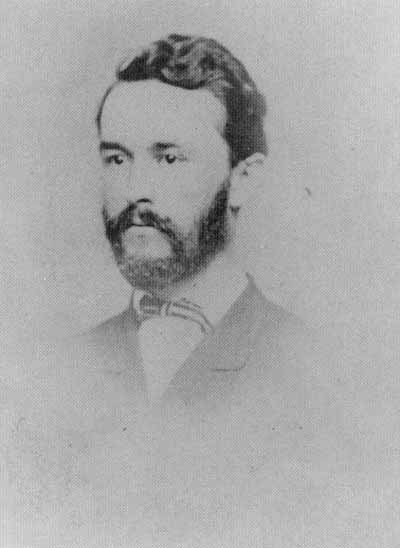
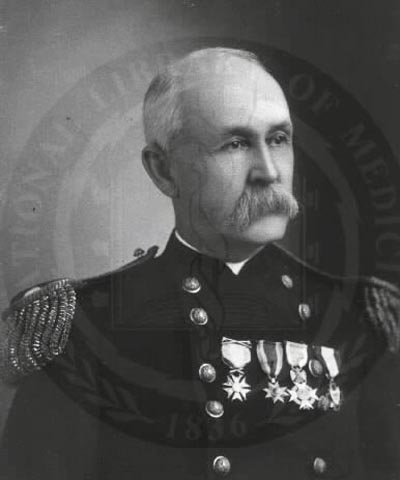
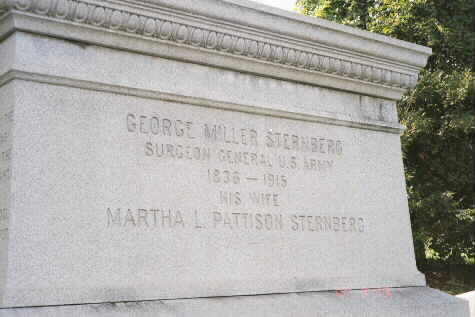
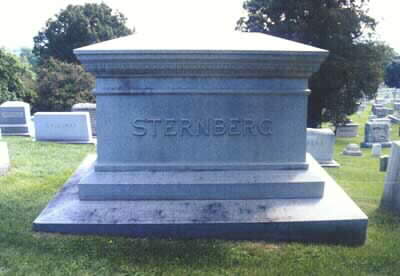
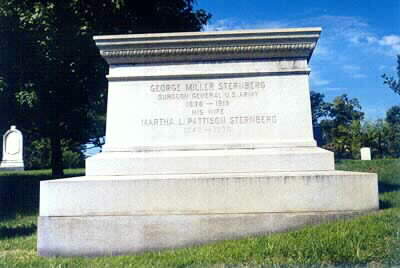
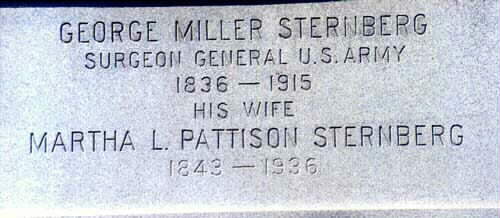
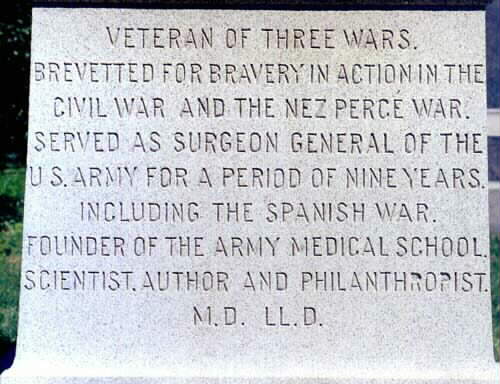
STERNBERG, GEORGE M
- BRIG GEN USA RETD
- DATE OF DEATH: 11/03/1915
- BURIED AT: SECTION 3 SITE 994
ARLINGTON NATIONAL CEMETERY
STERNBERG, MARTHA L W/O G M
- DATE OF DEATH: 02/23/1936
- BURIED AT: SECTION EAST SITE 994
- ARLINGTON NATIONAL CEMETERY
WIFE OF GM STERNBERG, BRIG/GEN SURG US ARMY
Michael Robert Patterson was born in Arlington and is the son of a former officer of the US Army. So it was no wonder that sooner or later his interests drew him to American history and especially to American military history. Many of his articles can be found on renowned portals like the New York Times, Washingtonpost or Wikipedia.
Reviewed by: Michael Howard

